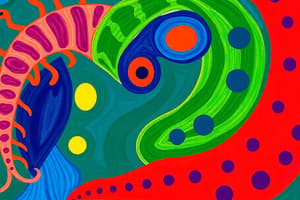Podcast
Questions and Answers
What is the characteristic of nematodes regarding their sexes?
What is the characteristic of nematodes regarding their sexes?
- They can be either male or female, or both.
- They have separate sexes, and can only be male or female. (correct)
- They have separate sexes, but can change from one to another.
- They are hermaphrodites, having both male and female reproductive organs.
What is the function of spicules in nematodes?
What is the function of spicules in nematodes?
- They are used for sensing the environment.
- They are used for movement and locomotion.
- They are used for reproduction. (correct)
- They are used for digestion.
Which of the following nematodes lays immature/nonembryonated eggs?
Which of the following nematodes lays immature/nonembryonated eggs?
- E. vermicularis
- S. stercoralis
- T. spiralis
- A. lumbricoides (correct)
Which classification of nematodes is characterized by the presence of caudal chemoreceptors?
Which classification of nematodes is characterized by the presence of caudal chemoreceptors?
Which of the following nematodes is found in the small intestine?
Which of the following nematodes is found in the small intestine?
What is the term for nematodes that do not lay eggs, but instead produce larvae?
What is the term for nematodes that do not lay eggs, but instead produce larvae?
What is the life cycle stage that is considered the most infective for many species?
What is the life cycle stage that is considered the most infective for many species?
Which stage does the larva molt to become after L2?
Which stage does the larva molt to become after L2?
Which nematode lays the most eggs per day?
Which nematode lays the most eggs per day?
Which layer of the Ascaris egg shell is described as lecithin membran?
Which layer of the Ascaris egg shell is described as lecithin membran?
Which nematode is known as the largest intestinal nematode?
Which nematode is known as the largest intestinal nematode?
What is the pathology caused by Ascaris lumbricoides known as?
What is the pathology caused by Ascaris lumbricoides known as?
Flashcards are hidden until you start studying
Study Notes
Trichiura Mnemonic: C.A.S.H. & T
- Trichiura: Extraintestinal Nematodes that affect Muscle, Lymph Nodes, Subcutaneous Tissues, Eyes, and Meninges
- Trichiura life cycle: L1 and L2 (Rhabditiform larva), L3 (Filariform larva)
Filarial Worms
- Lifecycle: Larval stage has three stages: L1 and L2 (Rhabditiform larva), L3 (Filariform larva)
- Developmental cycle: Molting (outgrowing and casting off old cuticle), Synthesis (creating new cuticle), Exsheathment (casting off old cuticle)
A. Cantonensis
- Life cycle: Eggs, L1, L2, L3, L4, Adult
- Infective stage: L3 stage
- Not all parasites have an L4 stage; medically important nematodes stop at L3
Intestinal Nematodes
Ascaris Lumbricoides
- Most common intestinal parasite in humans in the Philippines
- Largest intestinal nematode
- Adults lay 200,000 eggs per day
- Eggs become infective 2-6 weeks after deposition
- Egg characteristics: 85-95 micrometers length, 38-45 micrometers width, with layers (Vitelline membrane, glycogen, and mammillation)
- Stages: Unfertilized, Fertilized Corticated, Fertilized Decorticated, Embryonated
- Adult worm: Anterior head has trilobate lips, Pointed posterior tail in females, Curved posterior tail in males
- Pathology: Ascariasis, Member of the 'Unholy Three', Loeffler's pneumonia
Nematodes
- Characteristics: Elongated, cylindrical, bilaterally symmetrical, Unsegmented, Complete digestive system, No circulatory system, Dioecious
- Reproduction: Oviparous (lays immature eggs), Oviviparous (lays mature eggs), Viviparous/Larviparous (lays larva)
- Chemoreceptors: Amphids (cephalic), Phasmids (caudal)
- Classification: Phasmids (Subclass Secernentia), Aphasmids (Class Adenophorea)
- Habitat: Small intestine (C. philippinensis, A. lumbricoides, Hookworms), Large intestine (T. spiralis adult, E. vermicularis)
Studying That Suits You
Use AI to generate personalized quizzes and flashcards to suit your learning preferences.




